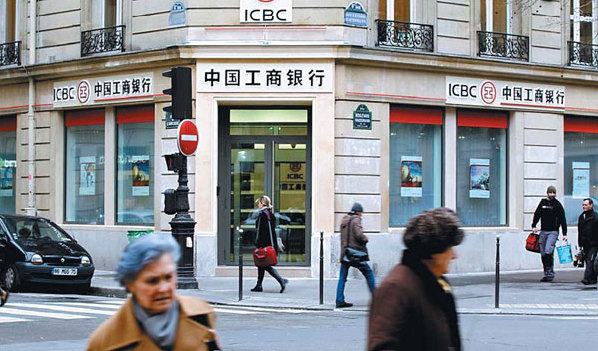France leads eurozone in offshore RMB payments
|
People walk past the entrance of the Industrial and Commercial Bank of China in Paris. Last month, 21.4 percent of the payments made between China and France were denominated in yuan. Charles Platiau / Reuters |
France now holds the leading position in euro countries for exchanging RMB payments, after recording a 249 percent growth in the value of payments since March 2012.
According to the Society for Worldwide Interbank Financial Telecommunication, or SWIFT, last month 21.4 percent of the payments made between China and France were denominated in yuan, against only 6.5 percent a year ago.
SWIFT said 95 percent of RMB payments made were institutional transfers, with 5 percent being customer payments.
France is ranked fourth in the world in terms of the value of offshore RMB payments- excluding Hong Kong and the Chinese mainland, trailing behind the United Kingdom, Singapore and Taiwan, according to SWIFT.
"This is an interesting development as it signifies France's drive to become a leading RMB trading center in Europe," said Lisa O'Connor, RMB director at SWIFT.
French acceleration in RMB payments reflects increased competition with the UK since the Bank of England announced that it had signed a three-year currency swap agreement with China in March, she added.
"It will be interesting to see how France's work toward setting up a currency swap agreement with China progresses, and the impact that this activity may have on the RMB."
Zhao Xijun, a professor at Renmin University of China, said France's location at the heart of the continent means it is perfectly positioned to handle more customer payments than other European cities.
"Robust consumer payments have led to more institutional transfers in the currency.
"And a large proportion of trade and investment between China and Europe is related to the country, which has helped France accumulate a yuan pool."
The RMB continues to ascend the ranks as a major international payments currency.
It is the 13th most-used currency overall with an all-time high market share of 0.74 percent.
Overall, RMB payments grew in value by 32.7 percent, in comparison to the average increase of just 5.1 percent across all currencies, according to SWIFT.
According to a report released by Standard Chartered Bank last week, 150 senior executives it surveyed in 16 locations globally in the first quarter said they planned to increase their use of yuan offshore products.
"Many foreign central banks have expressed an interest in holding more yuan assets, and we expect that within two years the currency will be widely adopted as a reserve currency," said Tommy Ong, a senior vice-president at DBS Bank.
The Reserve Bank of Australia announced on Wednesday it plans to invest 5 percent of its total foreign currency assets in Chinese sovereign bonds, making the currency its fifth-largest reserve currency after the US dollar, euro, Japanese yen, and Canadian dollar.
Philip Lowe, deputy governor of the Reserve Bank of Australia, said the People's Bank of China has approved the purchase of about $1.9 billion's worth.
The Australia and New Zealand Banking Group said that further liberalization of the offshore yuan market would improve liquidity and is fundamentally positive for the currency.
Bloomberg contributed to this story



















